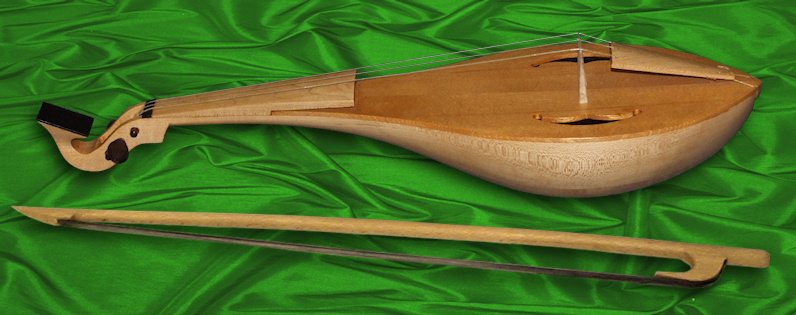 |
Soprano Rebec |

Soprano Rebec
The rebec is a European development of the Arabic rabab. It emerged in the 11th century, and died out in the early 16th century. For most of its life, it was a small instrument, but larger sizes were made towards the end of the 15th century, and it enjoyed a brief spell as a consort instrument. The Diabolus rebec is a typical 3-string model, based on various medieval illustrations. There is no firm evidence on tuning, so most people tune it in fifths, like a violin, or with a fourth and a fifth. The soundboard is slightly curved, and there is no soundpost. The sound is characteristically "reedy". It blends well with drones, and is excellent for dance music. The most common peg head shown in medieval illustrations is a simple flat plate, but there are a few illustrations of scroll pegboxes of varying complexity. I decided on a simple scroll, just because it looks pretty. The flat face on the end of the scroll can be a single piece of exotic wood, or can be inlaid. Prices
To order or enquire, pleasecontact me Cases - Excellent cases can be ordered from specialist manufacturers such as Kingham MTM, but they're pricy. I can supply an attractive, custom-built plywood case, black with chrome fittings, for £220 when ordered with an instrument. Delivery - the price depends on where you live. Please enquire. I hate it when websites say "Phone for a quote", so to give you some idea - getting a baroque guitar in its case to America, including insurance, is currently about £170. Getting one to Kent is about half that. Waiting time, from placing an order to clutching your new baby, is currently about 16 months. It's very approximate, because the schedule often contains items that are somewhat experimental, and they may take more or less time to complete than anticipated. Usually more. Deposit- I usually ask for £150 (non-returnable unless I'm dead, insane, incapacitated or incarcerated) to secure an order and cover materials. Once that's paid, your order is entered into my Magic Book. Nothing happens for several months, then you receive an email to tell you I've started construction. A few weeks later, a big parcel arrives, and you squeal with delight.
Anote on HUMIDITY - delicate wooden instruments are remarkably resilient, but
they can have major problems with both high and low atmospheric humidity levels. I keep my workshop at the
recommended humidity level, between 45% and 50%, and I strongly recommend that instruments are kept as close
to that range as possible. Electronic humidity meters are available cheaply on the Internet. They're small enough
to keep in your instrument's case. |
 More Instruments |
 Diabolus Homepage |
 Email for Diabolus |